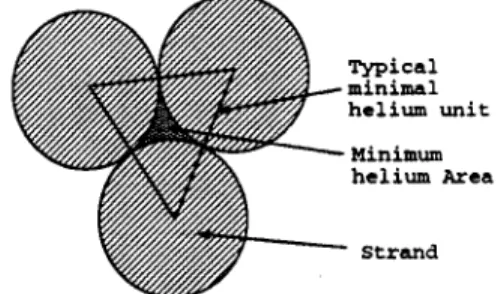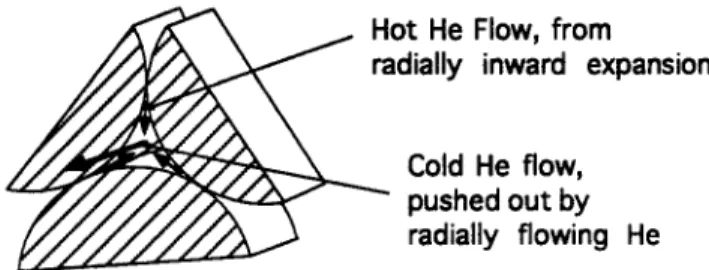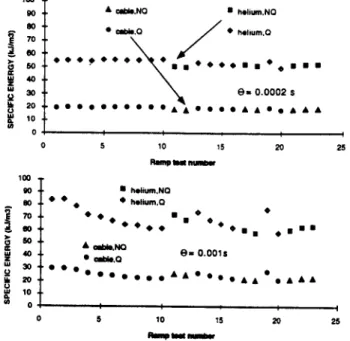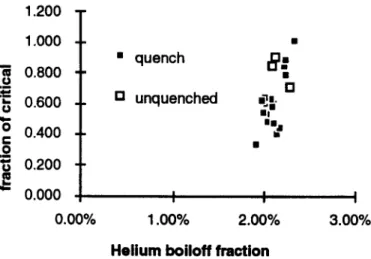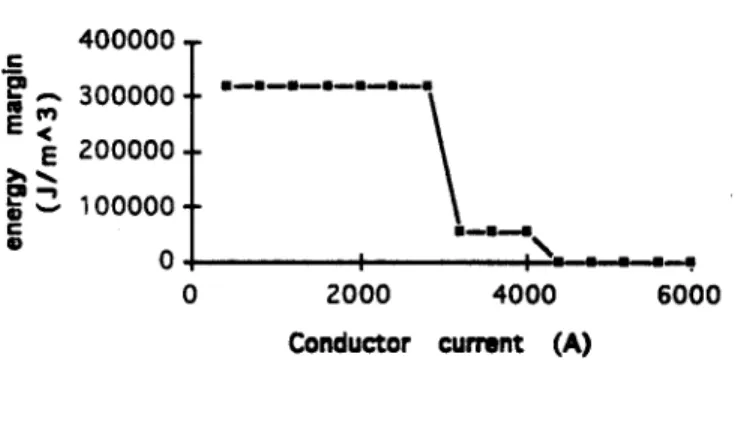PFC/JA-93-26
Anomalous Behaviour in ICCS
L. Bromberg, M. Takayasu and J. H. Schultz
Plasma Fusion Center
Massachusetts Institute of Technology
Cambridge, Massachusetts 02139
October 1993
Supported by U. S. Department of Energy through Princeton Plasma Physics
Laboratory Subcontract S-03528-G.
To be published in the Proceedings of the 15th Symposium on Fusion Engineering,
Hyannis, Massachusetts, October 11-15, 1993.
ANOMALOUS BEHAVIOUR IN ICCS
*
L. Bromberg, M. Takayasu and J.H. Schultz
Massachusetts Institute of Technology, Cambridge MA 02139
Abstract
ICCS
conductors behave anomalously. Sev-eral anomalies have been documented: quenches driven by pulsig fields (referred to as ramp-ratelimtations),
and energy margins that show atran-sition between a "well-cooled" and an "ill-cooled" regime (marking a transition between high energy margin at low transport current and low energy margin at higher currents). In this paper, a novel model will be described that attempts to interpret experimental data. In the experiments, 3 x 3 x 3
ICCS NbsSn sample coils have been tested for
sta-bility to ramping fields and transport currents. Three such coils have been tested, one made of triplets made of all SC strands, a second with one copper and two SC strands and a third one with one steel and two SC strands. The analysis deals mainly with unpressurized cases, but the model also applies to supercritical He. The hypothesis is that non-uniform helium and superconductor distribution in the conductor is the cause of the
"anomalous" behaviour. The energy margin as a function of the transport current has also been calculated, and it shows a transition. The limiting current is determined by the highest local fraction of bunching (averaged over a cross section). The model, however, has difficulty explaining multiple ramps.
1
INTRODUCTION
ICCS conductors behave anomalously when subject to
magnetic field and current variations. In this paper, the assumption that the non-uniform distribution of helium and conductor in the cable is the cause of the anomalous behaviour is tested experimentally and analytically. Two types of anomalies of ICCS will be addressed in this mem-orandum: the ramp rate limitations (quenching at lower ramp rates than would be expected) and energy margin.
The model hypothesizes that if the energy released in tightly bunched strands exceeds a lower critical limit, the helium in the tight "channels" vaporizes and the strands in the tight bunches quench. The current in these strands is transferred to the loosely bunched strands (with a large local helium fraction) that are still superconducting. If the current in these superconducting strands is larger than their critical current, then the entire conductor quenches. *This work was supported by DoE through PPPL subcontract
S-03528-G
The analysis deals mainly with the unpressurized pool boiling cases, but the model can be extended to supercrit-ical helium.
Section 2 describes the variations of He fraction across the cable and their implications. Section 3 describes the models used to calculate the AC losses. Section 4 de-scribes the experimental results and their analysis. Sec-tion 5 describes the implicaSec-tion of the results to super-critical He.
2 Helium fraction
The helium fraction in the conductor refers to the void volume divided by the total conductor volume. However, large local differences in helium fraction exist. The mini-mum fraction occurs when the strands are touching (tight strands, see Figure 1), resulting in the minimum void frac-tion
Fuemin = 2 - 7ra2/2 _10% 7ra2/2
where a is the strand radius. Typical average helium frac-tions are about 4 times larger, i.e. FHe,ave _ 40 %.
Typical minimal helium unit Minimum helium Area Strand
Figure 1: Schematic diagram of tightly bunched strands Helium has very small heat thermal conductivity, k _ 0.02 W/mK. The thermal equilibration time in helium is long, even in the case of supercritical helium:
pca2 1
In the case of pool boiling (unpressurized helium) it is assumed that the bubbles remain trapped by the strands, especially in the crevices between strands, as shown in Figure 1. The helium in these crevices experiences the largest temperature rise, since the helium fraction is the smallest and the heating input is the largest (due to the
largest metal fraction). Surface tension prevents the small bubbles formed in the crevices from leaving the system in the time scale of interest. The expansion of helium as it goes into the gas phase results in the expulsion of liquid helium to compensate for the volume increase of gaseous helium, as shown in Figure 2. The hot helium flow could be either in the gas or in the liquid phases (supercritical helium will be discussed below). After the channels are filled with gaseous helium, any additional heating to the wires will result in the local quenching of the superconductor (since the conductor has very little heat capacity).
Hot He Flow, from radially inward expansion
Cold He flow, pushed out by radially flowing He
Figure 2: Schematic diagram of cold helium expulsion from tight strands when helium in crevices expands radi-ally inward
Helium experiences an increase in volume of a factor of
8 as it goes from the liquid phase into the gas phase at
1
bar. This means that it is only necessary to evaporate about 12% of the helium in order for gaseous helium to totally occupy the volume in between strands.Using this information, it is possible to evaluate the parameters for filling 100% of the channel by the gaseous phase. Atmospheric helium evaporates with 20400 J/kg. Its liquid density is 125 kg/M3. The helium vaporization
energy is therefore 2.5 J/cm3. Since evaporating only 1/8 of the helium in the channel results in totally filling the channel with helium gas, the energy needed to fill the tightly bunched channels with gaseous helium is then 0.3 J/cm3. The local heating EHe,iocal with non-uniform void fraction can be shown to be
FHe,ave 1 - Fejocal Ee,oca1 = Eue,ave FHe,jocal 1 - FHe,ave
where FHe,ave and FHeLocaj are the average and the local helium fraction, and EHeave is the average heat input to the helium. It is assumed that the heat is generated uni-formly in the metal. If FM, 40% and Fn
.,,,v, - 0 a d e, j, n t
10%, then EHe,ave o EHe,min/6
. For EHe,min _ 0.3 J/cm3 (required to fill the tightly bunched channels with gaseous helium), EHe,ave - 50 mJ/cm3 (energy margin over the conductor of - 25 mJ/cm3). This implies very small energy margins for the regions with tight strands.
3 Hysteretic and Coupling Losses The hysteresis losses in the DPC strands are given by
Ehs, = 178.2 (1 - e-0 .21 3 ) x (1 + f2) mW/cm3
These losses are for a full cycle. In order to account for the quarter cycle, this equation needs to be multiplied by 1/4.
The losses are for a single strand, and many strands can result in non-uniform losses. This is due to the presence of fields external to the strands. Both larger and lower losses,
locally, are possible (if the strands are aligned with the magnetic field, the losses are smaller; if they are aligned orthogonally to the magnetic field, the losses are larger).
The coupling losses are given by B2 28 E, = -
-1o Tramp
E
varies for different cable composition and construction and also may vary longitudinally along the cable.uniform coupling losses could also exist. Non-uniform losses (both hysteretic and coupling) could be the explanation of the anomaly.
3.1 Hysteretic effects
The hysteresis losses depend on the previous history of the superconductor. Typical hysteretic loops for the DPC wire are shown in Figure 3 [4]. For the ramp experi-ments, the hysteretic losses will be different depending on whether the superconductor starts at point A (un-magnetized), point B (negatively magnetized) or point
C (positively magnetized). For the sets of unipolar field
experiments [1], the magnetic field does not reverse, only ramps-up and down.
External Field (ke
-W -40 0 40 ao
4 20A
-O -.0
. 4
-xteraiField (MA/nm)
Figure 3: Hysteresis loop for DPC wire
The heat dissipated for a unipolar cycle (ramp-up/ramp-down) is 42% of the losses for the (bipolar) cy-cle [3]. For the bipolar cycy-cle, about 25% of dissipation occurs in each quadrant. As shown in Figure 3, the dissi-pation for the ramp-down in the unipolar cycle is equiva, lent to the the dissipation in the ramp-down in the bipo-lar cycle, and approximately 25% of the dissipation for the full cycle. Therefore, the dissipation during ramp-up from the unipolar cycle are much lower than those of the
full cycle. The power dissipation during the ramp-up for
the unipolar are 17% of the dissipation in the full bipolar cycle, vs. 25% for the bipolar cycle. Therefore, differences of about 1/3 in the ener dissipated during ramp-up can occur because of the diference in the magnetization state of the conductor.
3.2 Stability Region
The proposed model implies two conditions for conduc-tor quenching. The first one is that the tightly bunched strands be filled with helium gas (an energy implication), and that the conductor current be larger than a given value (a fraction-of-critical implication.) The data can be shown with the fraction of critical in the ordinate and the energy margin in the coordinate.
According to the limiting-current model briefly de-scribed above, the instability region would be a box lim-ited by the limiting critical fraction (equal to the fraction of the conductors that are bunched) and by the critical energy, represented by the fraction of He boiloff.
4 Tests
There have been three types of experiments [1]. THe first one has current and field ramping. the second has only field ramping, and the third one has multiple field ramps. The experiments were conducted in three sets of sam-ple coils with 27 strands (3 x 3 x 3). The samsam-ple coils were single loop coils with different conductors, a 27 all-superconducting strand cable, a 27-strand copper hybrid (one of the wires in each triplet is pure copper) and a 27-strand steel (one wire of the triplets is steel). [11
100. so. 70. 80 4, 0 030. W 20 U S10. 0 0. C, 0 U 0. 0 100 90 70 so 40 30 10 0 Figure unque respon A cabes.NQ
Figure 4 shows the specific energy into the helium (higher points) and the specific energy into the conductor (lower points) for the Cu-hybrid coil. The points indicate, for each test, the AC energy
Figure 4 shows the calculated value of the AC energy losses at the time of quench or at the highest field (if unquenched). Each point corresponds to a different test, with 23 tests in total. Two cases are shown that indicate the variation with
E:
(a) shows the results forE
= 0.0005s, (b) shows the results for
E
= 0.001 s. If the model isappropriate and there is a maximum energy that can be deposited in the helium before the conductor quenches, it
is
clear that E) < 0.001 s. Only an upper bound on9
can be derived from comparison between the model and the experiments, due to the fact that coupling losses seem to be small. The e values estimated here agree well with measurements [2].The specific energy into the helium for all the tests an-alyzed are shown in Figure 5. e has been adjusted for the other conductors, being E) = 0.0005 s for the
steel-hybrid and for the all-superconductor coil. The were 21 tests for the hybrid steel conductor, and 28 for the all-superconductor conductor. The only results that deviate from the pattern in the last set of runs (all superconduc-tor, tests 57-60 and 65) are due to quenches during the down ramp and are improperly analyzed in the present work. It should be noted that the conductor quenches at high critical fractions.
Shelium.NO '.O . h.ium.O .*... . ,. . . . .. e- 0.0002 s 0e 0 0 0 AA ... OAA A.AA A 0 5 10 1520 25 . heiumNO - * hofium,O - eeo "o*, *em.e. e- 0.0013 so . 40-520 40 0 20
M
NO, hokum *o0. h.ilum N, bg* apt -A N. bl 0 . . 0 10 20 30 40 50 60 70 soFigure 5: Same as Figure 3, but showing results for all sample coils
The fraction of average helium that is vaporized is shown in Figure 6. It is very suggestive that once the o 5 10 15 20 25 average helium gas fraction reaches 3.5%, the conductor
... ". quenches.
The conclusion of this part of the study is that, with the 4: Specific energy at quench or highest field (if equations used, when energies of 50 mJ/cm' (theoretically nched) for the copper-hybrid cable. Each point cor- and experimentally) are deposited in the helium, the tight
ds to a different ramp test. Curves have varying strands cease to be superconducting. values of (9.
For each sample coil, many different ramp rates and maximum field/currents were tested. Losses have been calculated for each ramp rate test. The average energy densities (specific energy) deposited in the conductor and in the helium are also evaluated. The time constant E is determined by the best fit to the data, as described below.
4.1 Field ramping, constant current tests
As suggested above, the whether the coil quenches de-pends both on the energy dissipated and the fraction of critical. The quench/unquench boundary can be investi-gated by plotting the results of the tests shown in Figure 5 with the AC loss energy in the coordinate and the fraction of critical in the ordinate.
0 .- o
SNOQUENCH
o0 000
60 70
conductor sample coil. Figure 8 shows the results with the current and field ramping, with field ramping (single ramp), and first ramp-up of multiple cycles cases. Figure 8 shows that about 30% of the strands are tightly bunched (the boundary falls at about 70% critical, which, following the arguments above, means that 30% of the strands are tightly bunched). 0.025 002 0.01s 0.01 0.005 0'
Figure 6: Average helium fraction vaporized in the tests shown in Figure 4 .2~ LL 1.000 0.800 0.600 0.400 0.200 0.000
B
" DC, quench 13 DC, no quenchThe results for the steel hybrid cable experiments are shown in Figure 7. The coordinate shows the fraction of critical (current) at the time of the quench. Note that relatively low values of critical fraction,
fit
- 0.5 areneeded to quench these cables. This implies that a rela-tively large number of the strands in the region of tight bundles, about half. If half of the strands quench due to the AC losses, then the current in the unquenched strands doubles: with a critical fraction of 0.5, then the current in these strands exceeds the critical current, and the entire cable quenches. 1.200 -r 1.000
+
0.800 0.600 " quench .3 unquenched 0.400 + 0.200 0.000 a N 40 u-.. .-Ia 0i
i
2
1
0.00% 1.00% 2.00%Helium bolloff fraction
Figure 7: Stability/quench region for the steel hybrid sam-ple coil
Note that there are some points well inside of the box, when the boundaries of the box should be limiting. Possi-ble reason for the relatively large scatter will be described in Section 4.3.
4.2 Field ramping, constant current tests
A second class of tests were carried in which the field was
ramped with constant conductor current.
The cases of ramped-current and constant current are compared in this section, for the case of the steel hydrid
0.00% 1.00% 2.00% 3.00% 4.00%
Average Helium Boiloff Fraction
Figure 8: Stability/quench boundary for the steel hybrid conductor with constant current, varying field.
These results tend to confirm that the critical average helium boiloff is about 3%. independently of whether the current is ramped or not (for first order, the AC losses are not dependent on the current ramping, only on field vari-ations). Considering that for these cases the maximum local heating in the helium is about 6 times larger than the average, then the maximum local evaporation is 18%. Since the volume expansion of the helium from the liquid into the gaseous phase is about 7-8, then the volume in be-tween tightly bunched strands could be occupied entirely
by gaseous helium.
4.3 Premagnetization of the Sample Coil
To better characterize the measurements, it was suggested to run a half cycle with no current prior to each test. The tests were combined with the multiple ramp tests. The results for the first ramp for these tests are shown in Figure 8. Results indicated that it was more diffi-cult to quench the superconductor (indeed, the conduc-tor quenched only after operating near critical current), supporting the assumption that premagnetizing the su-perconductor reduces the dissipation.
However, there was additional energy dissipated in the conductor during the following ramps, and the model breaks down, as will be discussed below.
4.4 Multiple Ramps
To test whether the anomalous behaviour of the ICCS is due to energy rather than power margin, a set of experi-ments with multiple unipolar ramps of the magnetic field was designed. The conductor current was DC. Figure 8 shows the results of a calculation for the first ramp-up, but the field was ramped up and down 25 times. The figure is calculated assuming bipolar cycle dissipation, so
0.03 , so 4-0 C 0 10 20 30 40 50 to fM r- a A-0 C 02 6. ''P
the results need to be multiplied by a factor that could be as small as 17/25. Although the energy dissipated per ramp was not enough to quench the conductor, the model predicts that the first ramp-down or the second ramp-up would. Since the dissipated power in the ramp-down is the same as the energy during the ramp-up, at the end of the second ramp-down the average helium boiloff is about 8% x 42%/50% ~ 6%, substantially larger than the 3 - 4% that is necessary according to the model. Al-though the superconductor may not quench during the ramp-down since the fraction of critical is decreasing, it should quench during the second ramp-up, and it does not! At the present time, this is important evidence that the anomalous behaviour may not be due to a low energy margin.
The superconductor received substantial heat during the pulses. It is interesting to investigate the heat balance, as the sample coil did not quench even after 25 cycles.
The radii of the cable and helium is about 2.5 mm and that of the conduit is 3.1 mm. The energy dissipated in the conductor, q'" is about 101 W/m3 (10 mW/cm3
). The minimum q"' that quenches the sample coil, if the quench is determined by a power limit, is 10' W/m3
(1 mW/cm3)!!!
The total run time was about 250 s (5 s ramp-up and 5 s ramp-down, with 25 cycles). The total energy dissipated in the conductor is 2.5 J/cm3, which should quench the
conductor, but it does not.
It could be speculated that the conductor could be cooled via pool boiling to the helium bath outside the sample. The typical power that needs to be removed from the cable is about 1OW/m2 (1 mW/cm2)
(assum-ing that the helium itself does not carry the heat out in the form of bubbles leaving the conductor). The tem-perature differential across the 0.6 mm jacket is about
AT
- q"Ar/kjaket ~ 10-2 K. For the values being con-sidered, heat transfer is convective and very small tem-perature differentials (< .1K) are needed. A small degree of superheat is therefore all that is needed to remove the heat from the test coil. The superconductor can tolerate relatively large temperature rises (on the order of K's) without quenching.4.5 Energy Margin
The same model described above can be used to determine the results from the energy margin experiments. If the current in the strands with high void fraction (once the small void fraction ceases to be superconducting) exceeds the critical current, then the entire conductor quenches.
The process can be better understood if we identify that there are regions with different energy margins. The region with low void fraction has a low energy margin, and the high void fraction has a high energy margin.
The region of high energy margin has a helium fraction larger than the average. It is easy to show that the helium fraction in the unbunched strands is
FH.,..b = 1 - (1 -
7)
7
F 1 - FHe,ave 1 - Fe,min) where Y is the fraction of bunched strands. The minimum
Ei and maximum E2 energy margins are then
E, 0 F _emin_ 1 - FHe,ave 3 Eia 300 i Fu \1 - FH i mJ/cm and 2 300 FHe,unb'( 1 - FHe,ave Mj/Cm 3 E FHeave 1 - FHeunb/
A simple model was built following the above
discus-sion. The results are shown in Figure 9. It simulates the results of energy margin. The fraction of the strands that are tightly bunched in a given cross section, fAunc1ed, is
assumed to be func1ed ~ 25%. 400000 300000 200000 E E C a -. .. . 100000
0
2000 4000 6000Conductor current (A)
Figure 9: Calculated fraction of critical
energy margin as a function of the The factor of 4 decrease in margin, and the relatively constant energy margin at the high currents, are reassur-ing. If there is a distribution of bunched fractions and of degrees of tightness, then the transition would be more smeared.
The ratio between the energy margins in the "well-cooled" and "ill-cooled" regimes depends on FHe,min/FHe,ave, while the limiting current is a function
of fbn.,ed.
5 Relevance to Supercritical Helium
The case of pool boiling has been analyzed above. It was concluded that when the energy going into the helium ex-ceeded 50 mJ/cm , the tightly bunched conductor would not be superconducting. The results agreed with the ex-periments carried out [1]. In this section, the critical en-ergy for supercritical helium is calculated.
Supercritical helium does not have the large change in volume experienced by the liquid to gas transition, but it is still substantial. The specific weight of helium at
6 bar is shown in Figure 10. Reduction in the available
enthalpy for cooling could also occur in the liquid phase. Similarly to the case with phase change, the liquid in the very tight spaces between conductors will expand due to the increased heat, and the fluid in the center of the space will be pushed out, as shown in Figure 1.
BEE.. U e U". U a, U aa aU 0 0 m on a a 4 5 6 7 8 9 10 11 12 13 Heium temperature (K) 300 T 250 1200 i 150 100 T 50 - a ^ 4 5 6 7 8 9 temperature (K)
Figure 10: Specific weight of helium at 6 atmospheres as a function of temperature
An estimate of the minimum energy required to raise the temperature of liquid helium in the channels can be obtained in the following manner: assuming that the he-lium experiences a volumetric expansion of C = pi/pf,
then the fraction of helium in the channels that needs to be heated is 1/(. Here pi and pf are the helium densities
at the initial and final temperatures (at constant pres-sure). The energy required to raise the temperature of the reduced volume is simply
AHpi.
When including the change in volume, the minimum energy density required to raise the temperature in the tightly bunched section of the conductor is given byEHe,min = AZHpf
The fact that the enthalpy change is multiplied by the final density is a surprising result. The corresponding helium energy input EHe,ave (averaged over the cross sec-tion) is then
EHe,ave = Eue,mzn FHe,min
1
- FHe,aje1 - FHe,min FHe,ave
Figure 11 shows EHe,ave curve for the case of helium at
6 atmospheres, for FHe,min = 10% and FHe,ave = 40%.
Note that after 8 K, EHe,ae saturates. This is due to the fact that the change in volume more than compensates for the increase in enthalpy.
If the superconductor current sharing temperature is
about 7-8 K, then the average helium energy EHe,a, is
about 250 mJ/cm (with a corresponding value of energy margin - 120 mJ/cm' for the tight strands). This value is about a factor of 5 larger than for pool boiling.
6 Discussion
The hypothesis of non-uniform helium distribution as the reason for the anomaly of ICCS was tested.
Although the initial tests supported the hypothesis, the latter evidence (multiple ramp rates) points away from an energy limit as the reason for the
ICCS
anomalous be-haviour. The multiple pulses tests (with ramping field)Figure 11: Minimum heat that results in expulsion of cold coolant from the tight channels
did not show any tendency to quench, up to the criti-cal current. The results from the premagnetized experi-ments indicate that the stability for premagnetized cases increases. Finally, it was not possible to quench the su-perconductor at fixed current with field ramping until the conductor current was close to critical.
The cable is cooled by the bath surrounding the sample. This could be the reason why the superconductor did not quench with the multiple pulses.
One possible manner to prevent the non-uniform dis-tribution is by braiding the conductor. Both a braided conductor and a twisted conductor were wound by the
NET team [5]. The model would predict that a uniform
cable would show less anomaly than the non-uniform con-ductor.
Another possibility is to design to a fraction of critical that is lower than 1 - r (rq is the fraction of bunched
strands). Then if the tight strands quench, the unbunched strands still can carry the current without quenching. A much larger energy margin (E2) can be obtained this way.
However, the higher value E2q would still be substantially
smaller than previously calculated, even for supercritical fluids.
References
(1] Takayasu, M., elsewhere in this conference.
[2] Takayasu, M., MIT Plasma Fusion Center, unpub-lished report (1990)
[3] Gung, C-Y, MIT Plasma Fusion Center, unpublished
report (1992)
[4] Provided by J. Minervini, MIT Plasma Fusion Cen-ter; measurements carried out by NIST
(5] P. Bruzzone, IEEE Trans Magn 28 190, 1992
35 ; 30 t 25 20 315 t 10 5 i 0 ,. ..- """""""eno""" 10 11 12 13
